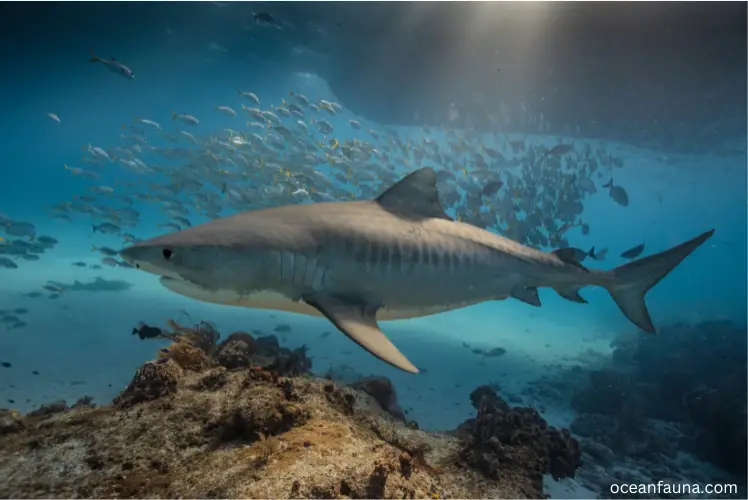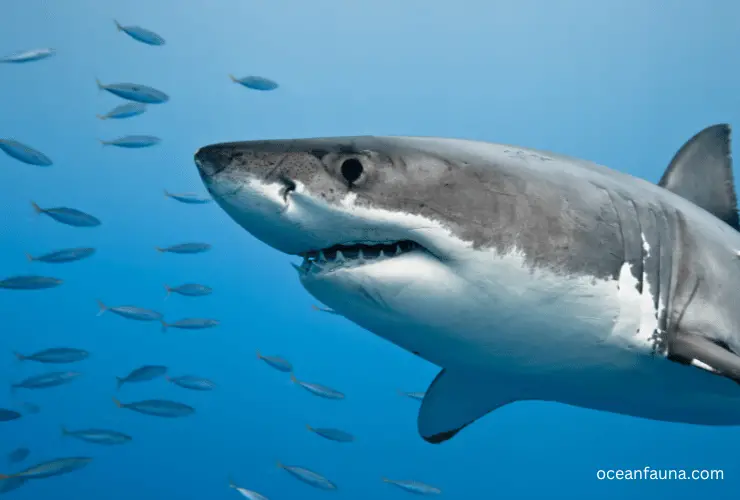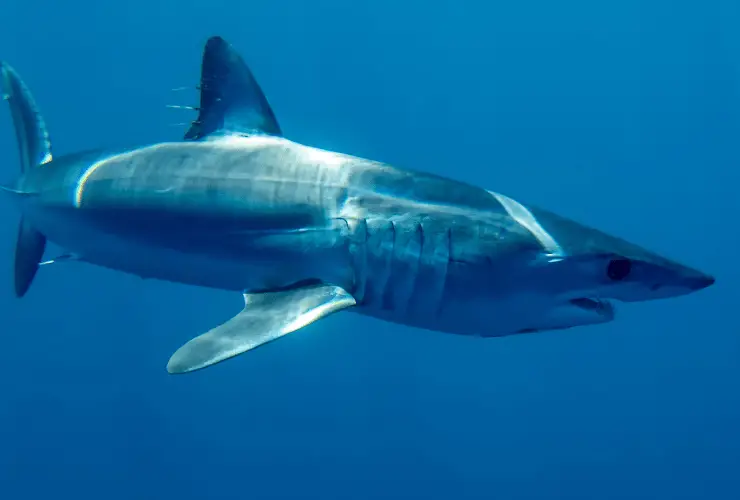Are sharks cold-blooded? In simple words, most shark species are cold-blooded. However, some sharks are warm-blooded.
Cold-blooded animals rely on their environment to regulate their body temperature. In this article, I’ll discuss the adaptation of sharks to their cold-blooded nature.
Are Sharks Cold-Blooded?
Sharks are generally classified as cold-blooded animals, which means their internal body temperature largely depends on the surrounding water’s temperature. This physiological process is known as poikilothermy or ectothermy. The vast majority of shark species cannot regulate their body temperature like warm-blooded mammals do.
Instead, they rely on external factors to maintain their internal body temperature within a specific range. The metabolic rate of a cold-blooded shark increases as the water temperature rises, allowing them to swim faster for short periods of time, but they will also tire more easily. Similarly, in colder water, the metabolism of these sharks slows down, which can make them sluggish.
However, with technological advancements and scientific research, experts have found some exceptions to the rule. An article published in The New York Times in 2015 highlighted a study that found that some species of sharks, such as the great white and the mako shark, can maintain some level of internal body warmth.
This physiological adaptation is known as regional endothermy, which is the ability to keep certain parts of the body warmer than the surrounding water. They do this by using a network of blood vessels called a rete mirabile, which acts like a heat exchanger, allowing the shark to retain heat generated during swimming muscles’ activity.
Additionally, some sharks exhibit various levels of homeothermy, which is the ability to maintain a constant internal body temperature. Hammerhead sharks, for instance, have a specialized organ known as the ampullae of Lorenzini, which enables them to sense temperature changes in the water and adjust their body temperature accordingly.
Why Cold-Blooded Sharks Are Considered Cold-Blooded?

Most sharks are classified as cold-blooded animals because they lack the ability to maintain a constant internal body temperature. This means their internal body temperature solely depends on the temperature of their surrounding environment.
Their physiological process of maintaining a body temperature is referred to as poikilothermy or ectothermy. The following are the reasons why cold-blooded sharks are considered cold-blooded:
Dependence on External Factors
Unlike warm-blooded sharks and mammals, cold-blooded sharks cannot regulate their internal body temperature without the assistance of external factors.
The metabolic rate of a cold-blooded shark increases as the water temperature rises, allowing them to swim faster for shorter periods of time, but they will also tire more easily. Similarly, in colder water, the metabolism of these sharks slows down, which can make them sluggish.
Reliance on Water Temperature
Since most sharks are ectothermic, their body temperature depends on the surrounding water’s temperature. Environmental temperature shapes the metabolic rate of sharks.
A decrease in temperature decreases the activity of metabolic enzymes in the body of many fish species, including sharks, causing a decrease in body temperature, a slow rate of movement, and metabolic function. At low temperatures, a shark’s metabolic rate drops, leading to the sluggishness observed in cold waters.
Absence of Heat-Generating Tissue
Cold-blooded sharks do not have heat-generating tissues like those seen in warm-blooded animals. These tissues allow warm-blooded animals to maintain a constant body temperature.
Cold-blooded sharks are immune to hypothermia during exposure to cold water due to the presence of a counter-current exchange process between blood vessels. Despite this, they still consider cold-blooded because their internal body temperature falls sharply in cold water.
Which Sharks Are Warm-Blooded?
The Lamnidae family of sharks is known for their warm-blooded or endothermic capabilities. This family includes some of the most popular shark species, such as the Great white shark, both longfin and shortfin mako, thresher shark, porbeagle, and salmon shark. Below is a detailed explanation of each of these sharks and how they are warm-blooded.
Great white shark

The Great white shark is one of the most popular shark species in the world. It is also one of the most feared sharks due to its size and predatory behavior. However, the Great white shark is one of the six species of sharks that are warm-blooded or endothermic. This means that they can regulate their body temperature internally, keeping it warmer than the surrounding water.
The Great white shark is able to maintain a warm body temperature using a system called the rete mirabile. This system consists of a network of arteries and veins that are arranged in a counter-current exchange system.
The muscles heat the blood that flows through the arteries, which generate heat during swimming. Then, as the blood flows through the network of veins, it gives off heat to the surrounding cooler blood returning to the heart.
This warm-blooded adaptation enables the Great white shark to have a higher metabolism, which allows it to swim at higher speeds and hunt for prey in colder waters.
Longfin and Shortfin Mako

The Shortfin and Longfin Mako sharks, also members of the Lamnidae family, possess warm-blooded characteristics. Renowned for their speed and agility, these sharks are formidable predators in the ocean.
Similar to the Great white shark, both Longfin and Shortfin Mako sharks utilize the rete mirabile system to regulate their internal body temperature. By maintaining a warmer body temperature than the surrounding water, these sharks can swiftly traverse vast distances at high speeds, effectively covering expansive ocean areas in search of prey.
Thresher Shark
The Thresher shark, a member of the warm-blooded Lamnidae family, possesses remarkable characteristics. These sharks are distinguished by their elongated tails, which they employ to stun their prey before devouring them. Additionally, Thresher sharks possess a remarkable warm-blooded trait that pertains to their eyes.
These sharks possess a specialized network of blood vessels in their eyes, allowing them to sustain a temperature up to 18 degrees Celsius higher than the surrounding water. This adaptation enhances their visual capabilities in colder waters, offering them a competitive edge when hunting for prey.
Porbeagle Shark
The Porbeagle shark is another Lamnidae shark that is warm-blooded. These sharks are often found in colder waters and have a unique adaptation that helps them regulate their body temperature.
Like the other Lamnidae sharks, Porbeagles have a rete mirabile system that allows them to maintain a warmer body temperature than the surrounding water. However, Porbeagles also have a special counter-current heat exchange system in their veins that helps them retain heat and stay warm in colder waters.
Salmon Shark
The Salmon shark is the last species of shark in the Lamnidae family that is warm-blooded. These sharks are found in colder waters and have a unique adaptation that allows them to maintain a warm body temperature.
Salmon sharks have a special network of blood vessels in their muscles called “red muscles.” These muscles generate heat during swimming, which is then passed on to the surrounding tissues and organs. This adaptation allows Salmon sharks to maintain a higher metabolism, swim faster, and hunt for prey in colder waters.
What Water Temperature Do Cold-Blooded Sharks Prefer?

Cold-blooded sharks can live in both cold and warm water as they are ectothermic, so their body temperature adapts to the surrounding water temperature. The water temperature affects cold-blooded sharks’ metabolism, growth, and reproductive rate.
The preferences for water temperature vary among different species of sharks. Deep-sea species such as the Greenland shark, which can be found in the Arctic’s coldest waters, have preferred water temperatures close to freezing.
On the other hand, some shallow water species, such as the blacktip reef shark, prefer warmer waters with temperatures ranging between 22°C to 30°C.
The Galapagos shark, which inhabits the warmer waters of the Pacific Ocean, has been found to have a thermal preference between 22°C to 27°C. This indicates that different populations might have varying thermal preferences even within species.
Additionally, the water temperature plays a crucial role in the migration patterns of sharks. Some species migrate to warmer waters during colder months to maintain their preferred body temperature, while some travel to cooler waters during hot summer months to avoid overheating.
What Water Temperature Do Warm-Blooded Sharks Prefer?
Warm-blooded sharks, also known as endothermic sharks, have the ability to regulate their internal body temperature, giving them a unique advantage in colder water. However, this does not necessarily mean that they prefer warm water over cold water.
In fact, warm-blooded sharks can be found in various water temperatures, ranging from frigid Arctic waters to warm tropical seas. Some species of warm-blooded sharks, like the great white shark, have been known to frequent colder waters, while others, like the silky shark, are more commonly found in warmer waters.
The temperature preferences of warm-blooded sharks can vary based on several factors, such as their species, habitat, and prey availability. For instance, great white sharks tend to favor waters with temperatures around 10°C, whereas species like the shortfin mako prefer warmer temperatures ranging from 18°C to 22°C.
Some warm-blooded shark species, like the porbeagle shark, possess a lower metabolic rate, enabling them to thrive even in colder waters.
In general, warm-blooded sharks exhibit adaptability to a broad range of temperatures due to their ability to retain and generate heat, which grants them the advantage of operating in diverse environments compared to their cold-blooded counterparts.
Conclusion
Hopefully, you understand that not all sharks are cold-blooded. Some of them are warm-blooded. This incredible adaptation has allowed some species to survive in extremely cold temperatures where other sharks could not. Feel free to ask if you have any further questions regarding this topic.

